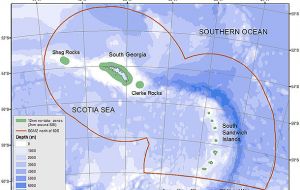MercoPress. South Atlantic News Agency
South Georgia Marine Protected Area covers over one million sq kilometres
 Maps showing the extent of the new MPA around South Georgia and the South Sandwich Islands
Maps showing the extent of the new MPA around South Georgia and the South Sandwich Islands One of the worlds largest Marine Protected Areas (MPA) has been created around South Georgia and the South Sandwich Islands, waters that are amongst the most productive in the Southern Ocean. The SGSSI MPA, which was declared on February 27th, covers more than 1 million km². The report is from the South Georgia Newsletter, February edition.
David Attenborough, who recently presented the BBC’s Frozen Planet series, said he was “delighted” and that the marine reserve was “...timely given the dramatic change that the Polar Regions are currently undergoing” and will “help protect the unique and precious wildlife of South Georgia and Antarctica.”
All commercial bottom trawling is banned from the area, which will protect the benthos on the seafloor. Long-lining will be allowed, but only at depths of more than 700m, and will only affect a small area of the MPA and is only allowed under very strict regulation. There are also already three Restricted Impact Areas, occupying 3563km², in which long-lining is not normally allowed. They were established to protect vulnerable benthic fauna, protect juvenile toothfish and provide a refuge for large toothfish.
Commissioner Nigel Haywood, who signed the legislation said, “The waters around South Georgia and the South Sandwich Islands are among the most productive in the Southern Ocean, with very high biodiversity. We remain committed to the highest standards of environmental management in this unique and globally important UK Overseas Territory. Whilst today’s MPA announcement represents a hugely significant step in our management of South Georgia and the South Sandwich Islands, we will not rest on our laurels and will continually strive to improve our already excellent management of the Territory.”
UK Foreign Office Minister Henry Bellingham welcomed the declaration, saying the instatement of the MPA, “demonstrates the UK’s effective environmental stewardship of this unique and remote part of the world.” and that it demonstrates the UK's “ongoing commitment to marine conservation and protection of the globally important biodiversity of our Overseas Territories.”
The MPA includes 'no-take zones' for the first 12 nautical miles around each island, including Shag Rocks. These no-take zones (over 20,000 km² in total) will protect the foraging grounds of many of the Territory's land-based marine predators such as penguins, seals and seabirds and protect the spawning areas of many demersal fish species.
GSGSSI will continue to license fisheries for toothfish, ice-fish and krill in the MPA (outside of the no-take zones) and use the revenue to patrol the region to prevent illegal fishing and undertake research and monitoring. These fisheries are extremely carefully managed, with both the icefish and toothfish fisheries certified as sustainably managed by the Marine Stewardship Council.
The new MPA enshrines in law much of the existing protection in the SG Maritime Zone and represents an important and significant addition to a global network of MPAs - increasing the area of the world's oceans formally protected as MPAs by almost 25%.
Dr Martin Collins, Chief Executive of the Government of South Georgia and South Sandwich Islands said, “South Georgia and the South Sandwich Islands are remarkable places, supporting an amazing density of wildlife. Establishing the SGSSI MPA is a key part of our long-term stewardship of the islands and demonstrates that, even in a place as special as South Georgia, you can have sustainable fisheries with minimum impact on the ecosystem.”
Dr Phil Trathan, Head of Conservation Biology at the British Antarctic Survey, who advised the Government of South Georgia on the establishment of the MPA said, “South Georgia is a globally important island that deserves the strongest level of protection. I believe that this is a major step forward for conservation, not just at South Georgia, but also for the wider Antarctic.”
The area to the south of the South Sandwich Islands, below the 60° latitude, is not included in the new MPA because it is already a 'no take zone' and GSGSSI does not issue licences to fish in this area, however it does protect the area of its Maritime Zone that lies south of the line.
In future there may be even greater protection within the new MPA as a result of two current projects, one funded by the Darwin Initiative to investigate benthic biodiversity and possible threats to it from the longline fishery, and another, funded by the Overseas Territories Environment Program, focusing on krill. Both projects will be completed in April 2012.




Top Comments
Disclaimer & comment rules-

-

-

Read all commentsIt is a very original way to find a good argument more easily acceptable for the world community, but with the only objetive of stealing a huge area of sea and land. Please uk don´t try to lie anymore, all the world knows the pirates history of this imperialist country.
Mar 10th, 2012 - 06:34 am 0I have done a rather good job of ignoring you for some time but now I must ask you a question....
Mar 10th, 2012 - 07:05 am 0Who, exactly , have the British stolen this 'huge area of sea and land' from?
Yes johnfarrel2050, who have they stolen this area from?
Mar 10th, 2012 - 08:28 am 0Commenting for this story is now closed.
If you have a Facebook account, become a fan and comment on our Facebook Page!